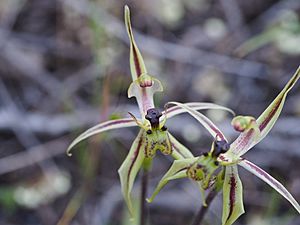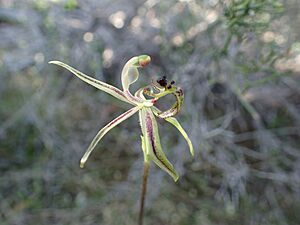Narrow-lipped dragon orchid facts for kids
Quick facts for kids Narrow-lipped dragon orchid |
|
|---|---|
 |
|
| Caladenia mesocera growing near Lake King | |
| Scientific classification | |
| Genus: |
Caladenia
|
| Species: |
mesocera
|
| Synonyms | |
|
Drakonorchis mesocera (Hopper & A.P.Br.) D.L.Jones & M.A.Clem. |
|
The Caladenia mesocera, also known as the narrow-lipped dragon orchid, is a special type of orchid. It grows only in the south-west part of Western Australia. This means it is endemic to that area.
This unique orchid has one tall, hairy leaf. It usually produces a single flower that is greenish-yellow and red. A cool part of this flower is its labellum, which looks a lot like an insect. Unlike many other orchids, this one is found more inland, away from the coast.
Contents
How to Spot This Orchid
The narrow-lipped dragon orchid is a perennial plant. This means it lives for more than two years. It is also a deciduous herb, which means its leaves fall off at certain times of the year. It grows from an underground tuber, which is like a storage organ.
Each plant has one hairy leaf that stands up straight. This leaf can be about 40 to 80 millimeters (1.5 to 3 inches) long and 4 to 10 millimeters (0.16 to 0.39 inches) wide.
Usually, only one flower grows on a stalk that is 80 to 250 millimeters (3 to 10 inches) tall. The flower itself is about 30 to 40 millimeters (1.2 to 1.6 inches) long and 20 to 30 millimeters (0.79 to 1.2 inches) wide. It has a mix of greenish-yellow and red colors.
Let's look at the parts of the flower:
- The dorsal sepal is the top part. It bends backward and is about 20 to 30 millimeters (0.79 to 1.2 inches) long.
- The lateral sepals are the two side parts. They spread out wide and are about 18 to 25 millimeters (0.71 to 0.98 inches) long.
- The petals are the colorful parts that look like wings. They are about 15 to 24 millimeters (0.59 to 0.94 inches) long and point downwards.
- The labellum is the most interesting part. It's like the orchid's "lip" and looks like an insect. It's about 10 to 15 millimeters (0.39 to 0.59 inches) long and is stiffly attached. This labellum is very hairy and has a greenish-yellow and red color. It even has a "false head" that is 2 to 3 millimeters (0.079 to 0.118 inches) across. On each side of this "head," there is a horn-like gland about 2 millimeters (0.079 inches) long.
This orchid blooms, or flowers, from August to early October.
How It Got Its Name
The Caladenia mesocera was first officially described in the year 2001. Two scientists, Stephen Hopper and Andrew Phillip Brown, gave it its scientific name. They published their description in a science journal called Nuytsia.
The second part of its scientific name, mesocera, comes from ancient Greek words. Meso means "middle" and ceras means "horn". This name refers to the small horn-like glands on the labellum. These horns are found in the middle part of the labellum, which helps tell this orchid apart from a similar one called C. barbarossa. The correct ancient Greek word for "middle" is actually mesos.
Where Does It Grow?
The narrow-lipped dragon orchid grows in several different natural areas of Western Australia. These areas are called biogeographic regions. You can find it between places like Bonnie Rock and Lake Moore, which is east of Wubin.
It lives in regions known as the Avon Wheatbelt, Coolgardie, Geraldton Sandplains, Mallee, and Yalgoo. This orchid likes to grow near salt lakes and in other spots that stay moist during the winter months.
Protecting This Special Plant
Good news! The Caladenia mesocera is currently considered "not threatened" by the Western Australian Government's Department of Parks and Wildlife. This means it is not in danger of disappearing right now.


